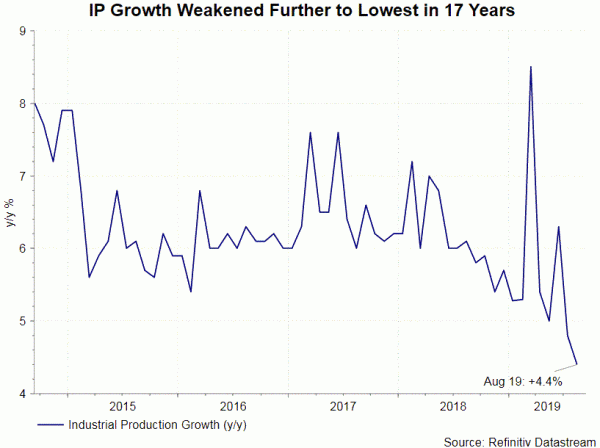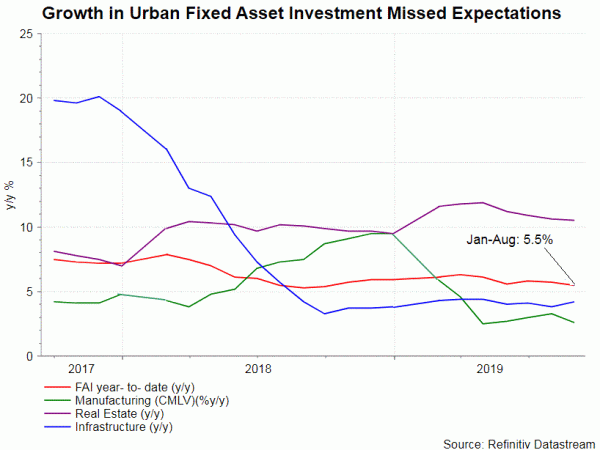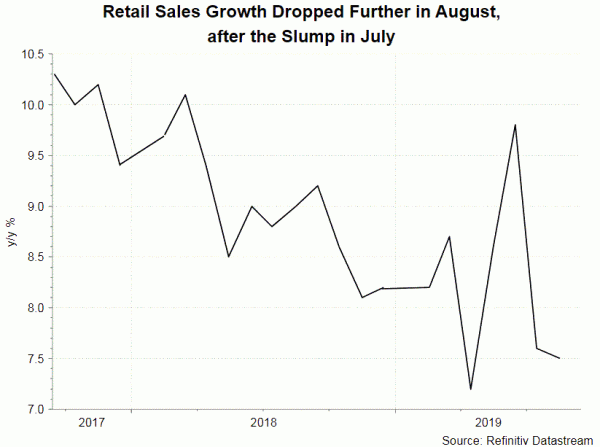China’s macroeconomic indicators showed significant weakness across the board. Industrial production gained +4.4% y/y in August, easing from +4.8% in the prior month. The growth rate came in weaker than consensus of +5.2% and marks the slowest in over 17 years. The rapid slowdown was partly driven by the cutback of production ahead of October 1. Local governments are required to clear the sky in preparation for 70th anniversary of Communist Party rule. The sharp slowdown in the mining sector growth to +3.7% y/y, compared with +6.6% in July, likely reflects this factor. Another reason was ongoing uncertainty in US- China trade war. Although US delayed the next round of tariff to October 16, chance of reaching a deal in October negotiations remains low.
 Domestic demand continued to suffer. Retail sales grew +7.5% y/y, compared with July’s +7.6% and consensus of +7.9%. Looking into the breakdown, auto sales declined -8.1% in August, exacerbating from -2.6% in July. Excluding auto sales, retail sales gained +9.3%, after a +8.8% growth in July. Fixed asset investment expanded +5.5% in the first 8 months of the year, compared with +5.7% in the fist 7 months. The market had anticipated a steady growth of +5.7%. Growth in real estate investment slipped -0.1 percentage point to +10.5% in the first 8 months of the year, while that in manufacturing fell -0.7 percentage point to +2.6% during the period. Growth in infrastructure investment climbed modestly to +4.2% in the year through to August, from +3.8% in the first 7 months. The improvement was limited despite the fiscal stimulus such as increased infrastructure spending and tax cuts.
Domestic demand continued to suffer. Retail sales grew +7.5% y/y, compared with July’s +7.6% and consensus of +7.9%. Looking into the breakdown, auto sales declined -8.1% in August, exacerbating from -2.6% in July. Excluding auto sales, retail sales gained +9.3%, after a +8.8% growth in July. Fixed asset investment expanded +5.5% in the first 8 months of the year, compared with +5.7% in the fist 7 months. The market had anticipated a steady growth of +5.7%. Growth in real estate investment slipped -0.1 percentage point to +10.5% in the first 8 months of the year, while that in manufacturing fell -0.7 percentage point to +2.6% during the period. Growth in infrastructure investment climbed modestly to +4.2% in the year through to August, from +3.8% in the first 7 months. The improvement was limited despite the fiscal stimulus such as increased infrastructure spending and tax cuts.
 Despite enormous infrastructure investment support, the economy continued to disappoint in August. Evidently, it is challenging for the government to achieve its growth target of 6-6.5% for 2019. Indeed, Premier Li Keqiang has attempted to guide market expectations, suggesting that it is “very difficult” to reach +6% growth this year, as the country is facing “certain downward pressure”.
Despite enormous infrastructure investment support, the economy continued to disappoint in August. Evidently, it is challenging for the government to achieve its growth target of 6-6.5% for 2019. Indeed, Premier Li Keqiang has attempted to guide market expectations, suggesting that it is “very difficult” to reach +6% growth this year, as the country is facing “certain downward pressure”.
We believe PBOC is obliged to announce more easing measures in the months ahead. Besides RRR cut, we expect the central bank to guide interest rates lower when the next round of medium-term lending facility (MLF) is launched on September 17 (tomorrow). This would come just ahead of FOMC’s meeting, at which the policy rate will likely be lowered by another -25 bps. Moreover, we expect one more RRR cut of -50 bpd by year-end.















